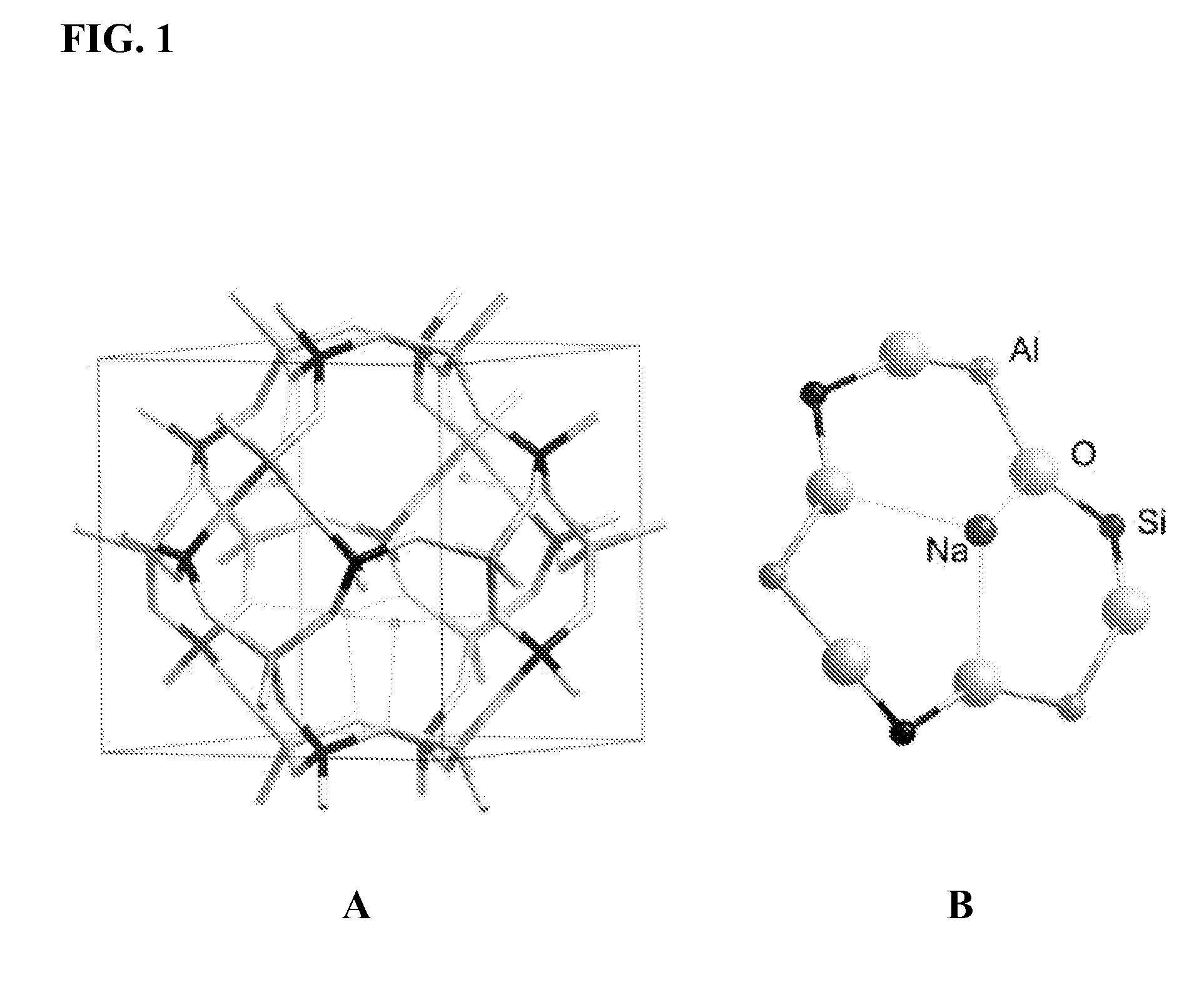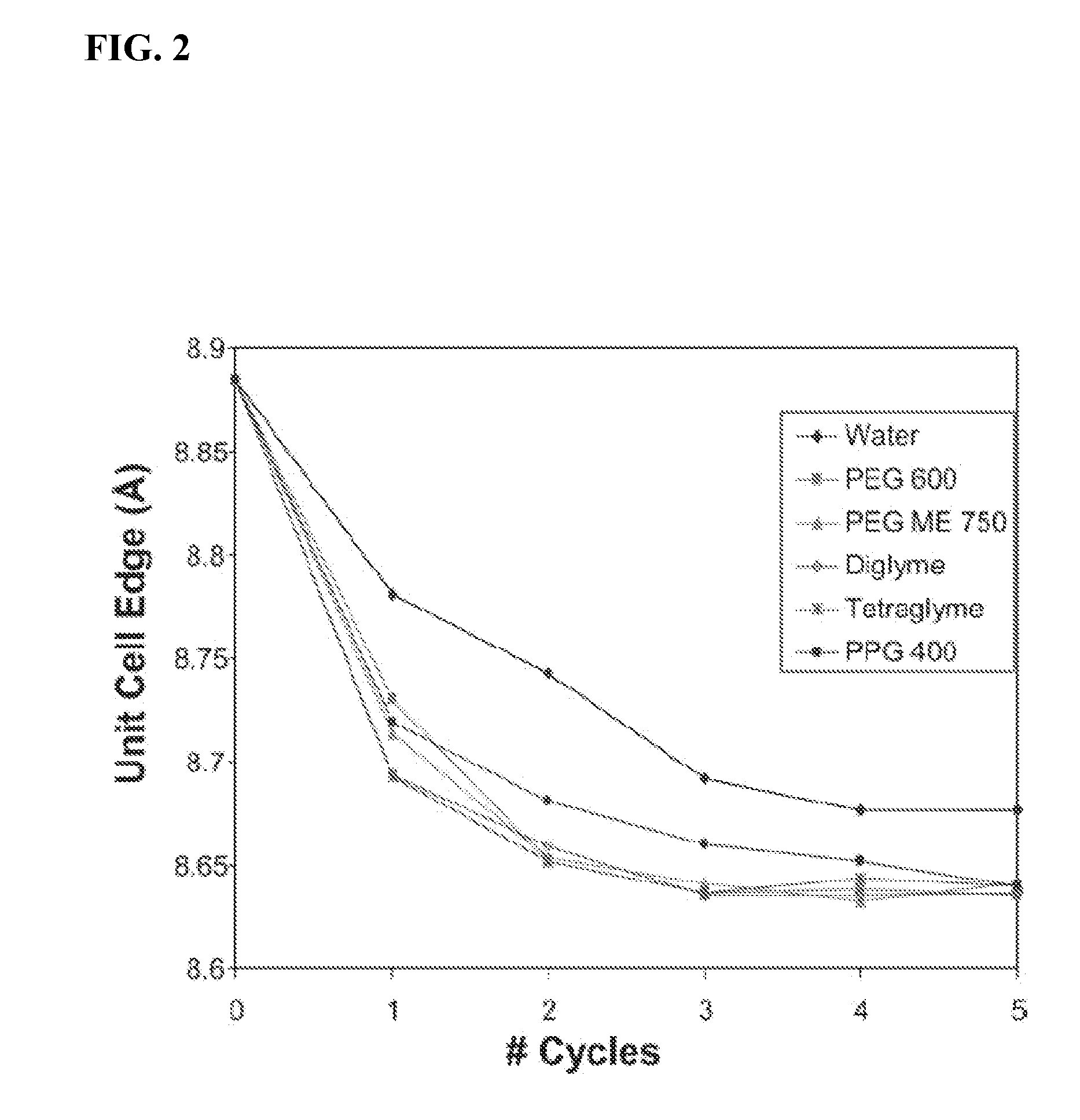Formulation and method for improved ion exchange in zeolites and related aluminosilicates using polymer solutions
a technology of ion exchange and zeolites, which is applied in the field of ion exchanged zeolites, sodalites, clay minerals, and related aluminosilicates, and methods for preparing these ion exchanged materials. it can solve the problems of undesirable metal hydroxide precipitates and breakage of the aluminosilicate framework, and achieve the effect of ion exchange chemistry of zeolites
- Summary
- Abstract
- Description
- Claims
- Application Information
AI Technical Summary
Benefits of technology
Problems solved by technology
Method used
Image
Examples
example 1
Hydrosodalite (Na6(AlSiO4)6.8H2O) Synthesis
[0127]The starting material for the preparation of hydrosodalite (Na6(AlSiO4)6.8H2O) was hydroxysodalite, Na8(AlSiO4)6(OH)2.2H2O, which was prepared hydrothermally from a basic solution of aluminum isopropoxide and tetraethyl orthosilicate, as follows. A 10.21 g (0.050 mol) amount of aluminum isopropoxide (Acros Organics, 98+%) and 40.0 g (1.0 mol) of NaOH (Fisher Chemicals, 99.8%) were added to a 125 mL PARR™ bomb Teflon liner, along with a magnetic stir bar. Deionized water (50 mL) was added and the mixture was stirred until the starting materials were completely dissolved and a clear solution was obtained, about 1 hour. A 10.53 g (0.0505 mol) amount of tetraethyl orthosilicate (Acros Organics, 98%) was then added to this mixture while stirring, after which water was added until the level of the mixture was about one inch from the top of the liner. The liner was covered and placed within the steel jacket, and the reaction mixture was heat...
example 2
Dehydrated Sodalite (Na6(AlSiO4)6) Synthesis
[0128]The starting material for the preparation of dehydrated sodalite (Na6(AlSiO4)6) was hydrosodalite (Na6(AlSiO4)6.8H2O), prepared according to Example 1. Hydrosodalite (Na6(AlSiO4)6.8H2O) was dried by heating the sample at 400° C. for 3 hours under a vacuum of 10−5 Torr, to substantially remove the water from the cage structure, to provide Na6(AlSiO4)6. The anhydrous ion exchange experiments used dehydrated sodalite, Na6(AlSiO4)6, prepared in this manner.
example 3
Hydrosodalite Ion Exchange Reactions
[0129]Exchange reactions of hydrosodalite were carried out by adding 1.72 g (0.025 mol) of LiNO3 (Fisher Chemicals, 99%) to 25.0 mL of either deionized water, polyethylene glycol 600 (HO[CH2CH2O]nH, n˜12-14), polyethylene glycol methyl ether 750 (HO[CH2CH2O]nCH3, n˜15-17), diglyme (H3CO[CH2CH2O]2CH3), tetraglyme (H3CO[CH2CH2O]4CH3), or polypropylene glycol 400 (Alfa Aesar, HO[CH2CH(CH3)O]nH, n˜6-7). A 0.125 g amount of hydrosodalite was added to each of these solutions which was then heated in sealed polypropylene bottles in an oven at 100° C. overnight (about 16 hours). The resulting sodalite was filtered off, washed with deionized water, rinsed with acetone, and collected for analysis using X-ray powder diffraction. This process was repeated in order to observe changes in the sodalite unit cell parameters after multiple cycles of exchange, for example after five cycles of exchange. The temperature was increased to 125° C. for the fifth cycle of ...
PUM
| Property | Measurement | Unit |
|---|---|---|
| temperature | aaaaa | aaaaa |
| molar ratio | aaaaa | aaaaa |
| boiling point | aaaaa | aaaaa |
Abstract
Description
Claims
Application Information
 Login to View More
Login to View More - R&D
- Intellectual Property
- Life Sciences
- Materials
- Tech Scout
- Unparalleled Data Quality
- Higher Quality Content
- 60% Fewer Hallucinations
Browse by: Latest US Patents, China's latest patents, Technical Efficacy Thesaurus, Application Domain, Technology Topic, Popular Technical Reports.
© 2025 PatSnap. All rights reserved.Legal|Privacy policy|Modern Slavery Act Transparency Statement|Sitemap|About US| Contact US: help@patsnap.com



